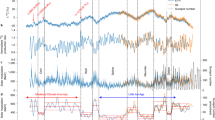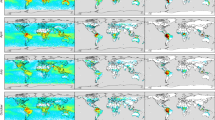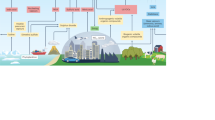Abstract
THE hydroxyl radical, OH, is the chief oxidizing agent in the atmosphere, and is responsible for removing many natural and anthropogenic trace gases1. At present, OH cannot be measured directly with sufficient accuracy over the spatial and temporal scales needed for global models of atmospheric chemistry2. Consequently, estimates of atmospheric OH abundance rely on a combination of models incorporating OH chemistry and observations of trace gases sensitive to OH. 14CO is an important diagnostic of OH abundance3–6. It is produced in the atmosphere mainly by the immediate oxidation of 14C produced by cosmic radiation, and it is subsequently removed more slowly through oxidation to 14CO2 by hydroxyl radicals7. The mean lifetime of14CO in clean air during summer in the middle and low latitudes is about one month, which makes 14CO a more sensitive indicator of OH than the longer-lived trace gases commonly used. Until now, only a few Northern Hemisphere 14CO determinations have been published3,8. Using accelerator mass spectrometry we present here an extensive set of 14CO data in New Zealand and several new Northern Hemisphere results. We find that Southern Hemisphere14CO concentrations are ∼40% lower than at comparable latitudes in the Northern Hemisphere. Such a large difference is surprising because the dominant sources and sinks are believed to be similar in both hemispheres. Although there are several complicating factors, from our results we suggest that OH abundances may be significantly higher in the Southern Hemisphere than in the Northern Hemisphere, in contrast to predictions using current photochemical models.
This is a preview of subscription content, access via your institution
Access options
Subscribe to this journal
Receive 51 print issues and online access
$199.00 per year
only $3.90 per issue
Buy this article
- Purchase on Springer Link
- Instant access to full article PDF
Prices may be subject to local taxes which are calculated during checkout
Similar content being viewed by others
References
Levy, H. Science 173, 141–143 (1971).
Altshuller, A. P. J. Air. Poll. Contr. Ass. 39, 704–708 (1989).
Volz, A., Ehhalt, D. H. & Derwent, R. G. J. geophys. Res. 86, 5163–5171 (1981).
Derwent, R. G. & Volz-Thomas, A. Global Ozone Research and Monitoring Project Rep. No. 20, Vol. 2, 127–146 (World Meteorological Organization, 1989).
Weinstock, B. & Chang, T. Y. Enviro. Biogeochemistry, Vol. 1, 39–49 (Ann Arbor Science, Ann Arbor, 1976).
Prather, M. Global Ozone Research and Monitoring Project Rep. No. 20, Vol. 2, 149–158 (World Meteorological Organization, 1989).
Weinstock, B. Science 166, 224–225 (1969).
MacKay, C., Pandow, M. & Wolfgang, R. J. geophys. Res. 68, 3929–3931 (1963).
Stevens, C. M. & Krout, L. Int. J. Mass Spectrom. Ion Phys. 8, 265–275 (1972).
Lowe, D. C. & Judd, W. J. Nucl. Instrum. Meth. B28, 113–116 (1987).
Wallace, G., Sparks, R. J., Lowe, D. C. & Pohl, K. P. Nucl. Instrum. Meth. B29, 124–128 (1987).
Brenninkmeijer, C. A. M. Analyt. Chem. 63, 1182–1184 (1991).
Stuiver, M. & Polach, H. A. Radiocarbon 19, 355–363 (1977).
Singh, H. B., Salas, L. J., Shiegeishi, H. & Scribner, H. Science 203, 899–903 (1979).
Isaksen, I. S. A. & Hov, O. Telus B39, 271–285 (1987).
O'Brien, K. J. geophys. Res. 84, 423–431 (1979).
Lingenfelter, R. E. & Ramaty, R. Radiocarbon Variations and Absolute Chronology, 513–535 (ed. Olsson, I. U.) (Wiley, New York, 1970).
Sauer, H. H., Zwickl, R. D. & Ness, M. J. Summary Data for the Solar Energetic Events of August through December 1989 (NOAA, Boulder, 1990).
Mathews, T. & Venkatesan, D. Nature 345, 600–603 (1990).
Cunnold, D. M. et al. J. geophys. Res. 88, 8379–8400 (1983).
Levin, I. et al. Radiocarbon 27, 1–19 (1985).
Manning, M. R. et al. Radiocarbon 32, 37–58 (1990).
Telegadas, K. United States Atomic Energy Commission HASL-243, TID-4500. (New York, 1971).
Holton, J. R. J. atmos. Sci. 47, 392–395 (1990).
Gidel, L. T. & Shariro, M. A. J. geophys. Res. 85, 4049–4058 (1980).
Lingenfelter, R. E. Rev. Geophys. 1, 35–55 (1963).
McConnel, J. C., McElroy, M. B. & Wofsy, S. C. Nature 233, 187–188 (1971).
Zimmerman, P. R., Chatfield, R. B., Fishman, J., Crutzen, P. J. & Hanst, P. L. Geophys. Res. Lett. 5, 679–682 (1978).
Crutzen, P. J., Heidt, L. E., Krasnec, J. P., Pollock, W. H. & Seiler, W. Nature 282, 253–256 (1979).
Spivakovsky, C. M., Yevich, R., Logan, J. A., Wofsy, S. C. & McElroy, M. B. J. geophys. Res. 95, 18,441–18,471 (1990).
Schnell, R. C. et al. Nature 351, 726–729 (1991).
Liu, S. C., McKeen, S. C. & Madronich, S. Geophys. Res. Lett. (in the press).
Kelly, K. K., Tuck, A. F. & Davies, T. Nature 353, 244–247 (1991).
Jacob, P. & Klockow, D. J. atmos. Chem. (in the press).
Manning, M. R. & Pohl, K. P. INS-R-350 (Institute of Nuclear Sciences, DSIR Wellington, 1986).
Author information
Authors and Affiliations
Rights and permissions
About this article
Cite this article
Brenninkmeijer, C., Manning, M., Lowe, D. et al. Interhemispheric asymmetry in OH abundance inferred from measurements of atmospheric 14CO. Nature 356, 50–52 (1992). https://doi.org/10.1038/356050a0
Received:
Accepted:
Issue Date:
DOI: https://doi.org/10.1038/356050a0
This article is cited by
Comments
By submitting a comment you agree to abide by our Terms and Community Guidelines. If you find something abusive or that does not comply with our terms or guidelines please flag it as inappropriate.



